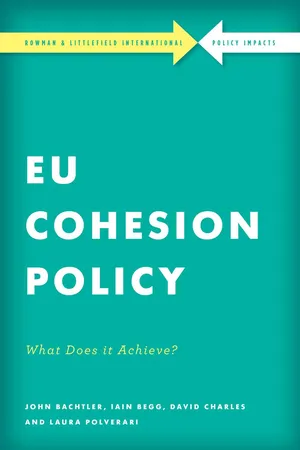As one of the two most prominent components of public expenditure from the EU budget (along with support for agriculture), the performance of EU Cohesion policy has been at the heart of debates on the effectiveness of EU spending for almost two decades (Mendez et al. 2011; Begg et al. 2014; Polverari and Bachtler 2014). In the late 1990s, one of the two core structural policy goals of the Agenda 2000 reform package was to “improve the effectiveness of the structural policy instruments so that economic and social cohesion can be achieved” (European Commission 1997). The impact and added value of the Structural Funds were also central themes of the negotiations on Cohesion policy reform in the 2004–2005 period (Bachtler et al. 2013) at a time when the contribution of cohesion spending to EU growth was seen as mixed at best (Sapir 2003; Bachtler and Gorzelak 2007). Most recently, the need to improve the performance and results of Structural and Investment Funds were important motivations for the reforms introduced in 2013 (Berkowitz 2015; Bachtler and Mendez 2016). And, looking forward to the post-2020 period, the issue of effectiveness has already been highlighted by EU Commissioner for Regional and Urban Policy Corina Creţu, focusing specifically on the lack of convergence of many lagging regions despite (in the case of southern Europe) decades of EU and national support (Creţu 2015).
The continuing debate on the effectiveness of the policy is not due to a lack of research. Since the major reform of the Structural Funds in 1988, there has been considerable academic inquiry and extensive evaluation on the performance of Cohesion policy, more so than in any other area of EU expenditure (Polverari and Bachtler 2014). Yet one of the curious features of the policy is that there is surprisingly little consensus on how well it works, how effective it has been in reducing regional disparities and improving the performance of supported regional economies, and how useful it has been in fulfilling the goals set for it. Academic research and evaluation studies have reached widely differing conclusions on the results of interventions through Structural and Cohesion Funds.
There are many plausible explanations for this apparent paradox. A first is that the policy has had multiple goals that have, moreover, evolved substantially over time, making it hard to arrive at a simple assessment of cause and effect. In each programme period since 1989, the design of programmes has been subject to different strategic objectives at EU level and (in some cases) changing regional eligibility status, as well as different national or regional government priorities on the use of EU funding.
Second, Cohesion policy is only one among many influences on the transformations affecting regional economies, and many of the other influences will be more telling, especially where the scale of funding accruing to the region is moderate. This means that isolating the specific contribution of Cohesion policy, while theoretically possible using appropriate statistical techniques, is subject to pronounced uncertainty.
Third, regional transformation is a long-run process in which different determinants have to come together optimally to create cumulative effects that only happen after lengthy, and uncertain, lags. Minimum thresholds—for example, for connectivity or quality of basic services—may need to be attained before a favourable outcome becomes plausible. The quality of government and specifically the administrative capacity in managing authorities, implementing bodies and beneficiaries will also influence the effectiveness of resource allocation and project delivery.
Lastly, there have been formidable obstacles to evaluation. Until recently, there were no reliable comparable data on how Cohesion policy funds were spent under different programmes. Data for programme outcomes have often been unreliable or absent, and it has been difficult to establish relationships between EU spending and regional indicators for income, employment or other measures of economic development.
Against this background, the aim of this book is to investigate the main achievements of Cohesion policy programmes and projects, and their effectiveness and utility, over the long term from 1989 to 2012. It is the first study to examine the longitudinal performance of the funds for the entire period in which they have been available since the 1988 landmark reform, and to assess performance across regions from different EU countries. Focusing on the European Regional Development Fund (ERDF) and Cohesion Fund (CF), the study addressed three main questions:
- To what extent did the programmes address regional needs and problems over time?
- To what extent did the achievements of the ERDF and CF meet regional objectives in each programme period and across the entire period from 1989 to 2012?
- What are the main lessons learnt on the effectiveness and utility of ERDF interventions?
In analysing what the funds have achieved, the study looks at three dimensions of performance: the outcomes recorded by the programmes; whether these outcomes met the objectives set for them; and whether the outcomes succeeded in meeting the needs of the regions where the ...
